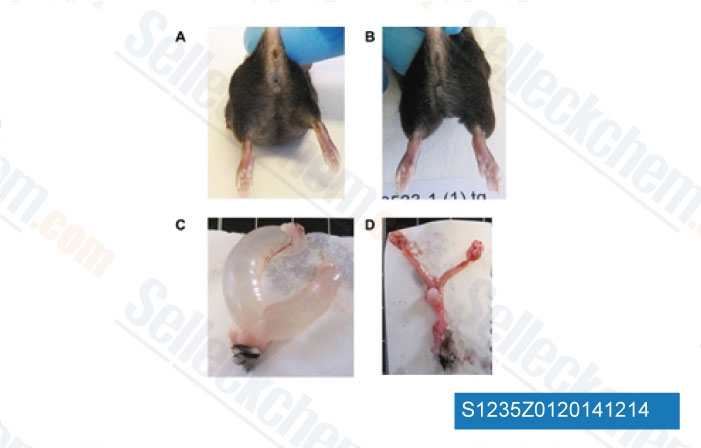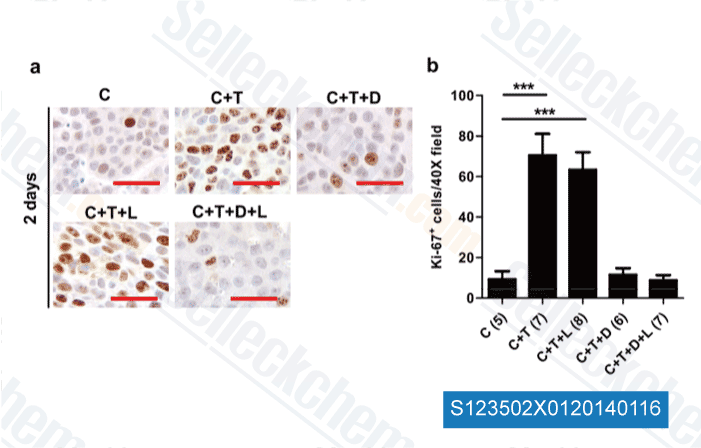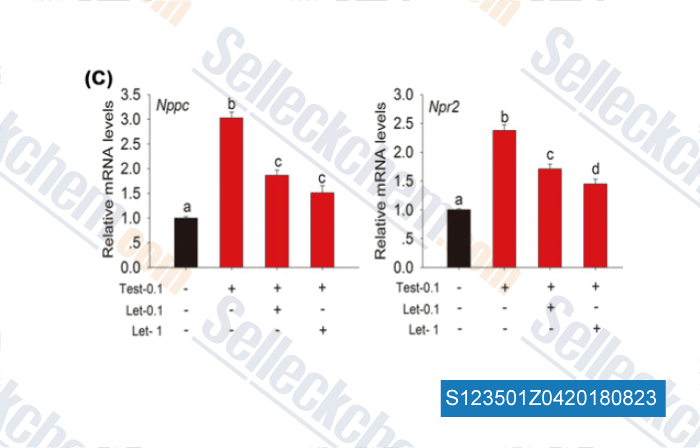|
Toll Free: (877) 796-6397 -- USA and Canada only -- |
Fax: +1-832-582-8590 Orders: +1-832-582-8158 |
Tech Support: +1-832-582-8158 Ext:3 Please provide your Order Number in the email. |
Technical Data
| Formula | C17H11N5 |
||||||||||
| Molecular Weight | 285.3 | CAS No. | 112809-51-5 | ||||||||
| Solubility (25°C)* | In vitro | DMSO | 57 mg/mL (199.78 mM) | ||||||||
| Water | Insoluble | ||||||||||
| Ethanol | Insoluble | ||||||||||
| In vivo (Add solvents to the product individually and in order) |
|
||||||||||
|
* <1 mg/ml means slightly soluble or insoluble. * Please note that Selleck tests the solubility of all compounds in-house, and the actual solubility may differ slightly from published values. This is normal and is due to slight batch-to-batch variations. * Room temperature shipping (Stability testing shows this product can be shipped without any cooling measures.) |
|||||||||||
Preparing Stock Solutions
Biological Activity
| Description | Letrozole is a third generation inhibitor of aromatase with IC50 of 0.07-20 nM in cell-free assays.It has no effect on the plasma levels of 17α-OH progesterone, thyroid-stimulating hormone (TSH), luteinizing hormone (LH), follicle-stimulating hormone (FSH), or androstenedione and does not affect normal urine electrolyte excretion or thyroid function in clinical studies. Letrozole induces autophagy. | ||
|---|---|---|---|
| Targets |
|
||
| In vitro | Letrozole potently inhibits aromatase derived from a variety of different sources including human placental microsomes, particulate fractions of human breast cancer, rat ovarian microsomes, MCF-7 cells transfected with aromatase (MCF-7Ca), JEG-3 human choriocarcinoma cells , CHO cells, hamster ovarian tissue, and particulate fractions of human breast cancer with IC50 of 11, 2, 7, 0.07, 0.07, 1.4, 20 and 0.8 nM. In the non-cellular systems, the IC50 of letrozole is calculated to be 1-13 nM. [1] Letrozole maximally inhibits estradiol production in vitro in LH-stimulated hamster ovarian tissue at 0.1 μM with an IC50 of 0.02 μM and does not significantly affect progesterone production up to 350 μM. In ACTH-stimulated rat adrenal tissue in vitro, aldosterone production is inhibited by with an IC50 of 210 μM. [2] Letrozole inhibits growth of the MCF-7 epithelial breast cancer cells in a dose-dependent way with IC50 of 1 nM. Inhibition can be observesed even at the very low concentrations tested (0.1 nM). Treatment of normal MCF-12A epithelial cells with letrozole did not affect their growth even when high letrozole concentrations (100 nM) or prolonged culture times. Concurrent administration of 17-β-estradiol with letrozole (10 nM) decreased the stimulatory effect of the enzymatic activity of MMP-2 and - 9 released by estradiol. [3] |
||
| In vivo | Letrozole inhibits aromatase in vivo with ED50 of 1-3 μg/kg p.o.. [2] Letrozole displays anti-endocrine effects. Letrozole inhibits androstenedione-induced uterine hypertrophy in immature rats with ED50 of 1-3 μg/kg. In the adult female rat, Letrozole (0.3-1 mg/kg daily p.o., 14 days) completely interrupts ovarian cyclicity and reduces uterine weight and serum estradiol (E2) concentrations to a similar extent to that seen after ovariectomy. [1] Letrozole induces dose-dependent regression of estrogen-dependent, 9,10-dimethylbenz-a-anthracene-induced mammary tumors in adult female rats. The ED50 for Letrozole is determined to be 10 - 30 µg/kg/day, with complete inhibition at a daily dose of 10 µg/day. [4] Letrozole produces dose-dependent inhibition of tumor growth of MCF-7 cells transfected with human aromatase gene (MCF-7Ca) implanted athymic nude mice, with complete inhibition at 20 mg/kg per day p.o.. [5] |
Protocol (from reference)
| Kinase Assay: |
|
|---|---|
| Cell Assay: |
|
| Animal Study: |
|
References
Customer Product Validation

-
Data from [Data independently produced by PLoS One, 2014, 9(1), e85581]

-
Data from [Data independently produced by Endocrinology, 2013, 154, 2296-307]

-
Data from [Data independently produced by , , Clin Sci (Lond), 2018, 132(7):759-776]

-
Data from [Data independently produced by , , Horm Behav, 2016, 83:60-7]
Selleck's Letrozole has been cited by 36 publications
| CDK4/6 inhibitors induce breast cancer senescence with enhanced anti-tumor immunogenic properties compared with DNA-damaging agents [ Mol Oncol, 2023, 10.1002/1878-0261.13541] | PubMed: 37854019 |
| SERPINA3-ANKRD11-HDAC3 pathway induced aromatase inhibitor resistance in breast cancer can be reversed by HDAC3 inhibition [ Commun Biol, 2023, 6(1):695] | PubMed: 37414914 |
| High p16 expression and heterozygousRB1loss are biomarkers for CDK4/6 inhibitor resistance in ER+breast cancer [ Nature Communications, 2022, 13, 5258] | PubMed: None |
| High p16 expression and heterozygous RB1 loss are biomarkers for CDK4/6 inhibitor resistance in ER+ breast cancer [ Nat Commun, 2022, 13-1:5258] | PubMed: 36071033 |
| Co-targeting CDK2 and CDK4/6 overcomes resistance to aromatase and CDK4/6 inhibitors in ER+ breast cancer [ NPJ Precis Oncol, 2022, 6(1):68] | PubMed: 36153348 |
| Establishment and Characterization of NCC-PMP1-C1: A Novel Patient-Derived Cell Line of Metastatic Pseudomyxoma Peritonei [ J Pers Med, 2022, 12(2)258] | PubMed: 35207746 |
| Establishment and characterization of NCC-UPS4-C1: a novel cell line of undifferentiated pleomorphic sarcoma from a patient with Li-Fraumeni syndrome [ Hum Cell, 2022, 10.1007/s13577-022-00671-y] | PubMed: 35118583 |
| Reducing local synthesis of estrogen in the tubular striatum promotes attraction to same-sex odors in female mice [ Horm Behav, 2022, 140:105122] | PubMed: 35101702 |
| MCM3 upregulation confers endocrine resistance in breast cancer and is a predictive marker of diminished tamoxifen benefit [ NPJ Breast Cancer, 2021, 7(1):2] | PubMed: 33398005 |
| Establishment and characterization of NCC-MFS4-C1: a novel patient-derived cell line of myxofibrosarcoma [ Hum Cell, 2021, 34(6):1911-1918] | PubMed: 34383271 |
RETURN POLICY
Selleck Chemical’s Unconditional Return Policy ensures a smooth online shopping experience for our customers. If you are in any way unsatisfied with your purchase, you may return any item(s) within 7 days of receiving it. In the event of product quality issues, either protocol related or product related problems, you may return any item(s) within 365 days from the original purchase date. Please follow the instructions below when returning products.
SHIPPING AND STORAGE
Selleck products are transported at room temperature. If you receive the product at room temperature, please rest assured, the Selleck Quality Inspection Department has conducted experiments to verify that the normal temperature placement of one month will not affect the biological activity of powder products. After collecting, please store the product according to the requirements described in the datasheet. Most Selleck products are stable under the recommended conditions.
NOT FOR HUMAN, VETERINARY DIAGNOSTIC OR THERAPEUTIC USE.
